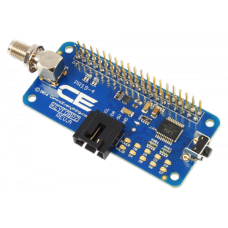Key Fob Receiver and I2C Expansion Port for Raspberry Pi Zero
The KEYFOBPZ is a dual-purpose I2C expansion port and Key Fob Receiver/Decoder shield compatible with Linx Technologies’ MS Series Key Fob Transmitters operating at 418/433MHz (1, 2, 3, 4, 5, 8-Button Transmitters Available Separately).
This device is capable of receiving button presses from a remote control up to 750 feet away (when using the 8-Button remote). When a remote control button is pressed, the on-board Valid LED illuminates. In addition, Raspberry Pi Zero I/O lines are asserted High for the duration of the remote button press. Raspberry Pi Zero I/O lines return to a low state when the remote control button is released.
Includes RP-SMA Antenna.
The On-Board LICAL Key Fob Decoder is Mapped to the following Raspberry Pi Zero Pins:
Key Fob Button 0 is Connected to Raspberry Pi Zero Pin 29 – GPIO5
Key Fob Button 1 is Connected to Raspberry Pi Zero Pin 31 – GPIO6
Key Fob Button 2 is Connected to Raspberry Pi Zero Pin 33 – GPIO13
Key Fob Button 3 is Connected to Raspberry Pi Zero Pin 35 – GPIO19
Key Fob Button 4 is Connected to Raspberry Pi Zero Pin 37 – GPIO26
Key Fob Button 5 is Connected to Raspberry Pi Zero Pin 40 – GPIO21
Key Fob Button 6 is Connected to Raspberry Pi Zero Pin 38 – DPIO20
Key Fob Button 7 is Connected to Raspberry Pi Zero Pin 36 – GPIO16
The KEYFOBPZ includes a level-shifted +5V I2C Expansion port for the Raspberry Pi Zero. The KEYFOBP2 acts as a gateway to the entire NCD I2C product line, allowing limitless expansion possibilities. This expansion could be one of the most significant expansions available for your Raspberry Pi Zero simply because of it’s broad expansion possibilities.
Integrated 4.7K pull-up resistors make it an ideal I2C master device. This I2C expansion port is compatible with our entire range of I2C devices, including relay controller, sensors, and various Mini Modules, making expansion of the Raspberry Pi Zero quick and easy, regardless of your application requirements.
NOTE: This expansion includes a pass-through connection for the Raspberry Pi Zero GPIO Header. However, this expansion makes extensive use of the Raspberry Pi Zero GPIO Header, and may render the GPIO port unusable for many expansions. Please exercise extreme caution when plugging other expansions into the pass-through header.
Features
- Adds I2C Expansion Port to Raspberry Pi Zero
- Adds Key Fob Receiver for Raspberry Pi Zero
- 1, 2, 3, 4, 5, 8-Button Remote Control Compatible
- Pairing Button with Valid Receive LED
- Up to 750 Foot Range with 8-Button Key Fob
- 418/433 MHz Operation with Integrated LICAL Decoder
Enter the code in the box below:





